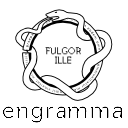Mnemosyne Atlas 40
Cortei dionisiaci
L'apprezzamento e la diffusione dello stile patetico anticheggiante già segnati dall'eccesso espressivo della Pathosformel (aggressione, fuga, difesa, disperazione) trova nella imago continuata delle scene a fregio (temi ovidiani ma anche l'episodio biblico della Strage degli Innocenti) un adatto stile narrativo (che sarà destinato a sfociare nella teatralizzazione barocca).
Dionysiac parades
The all'antica style showing the 'expressive excess' of the formulae of emotion (aggression, escape, defense, despair) is a widespread trend, and finds an apt narrative style in the imago continuata of frieze scenes (Ovidian subjects as well as the Biblical story of the Massacre of the Innocents). This agitated narrative style will lead to the dramatic style of the Baroque.
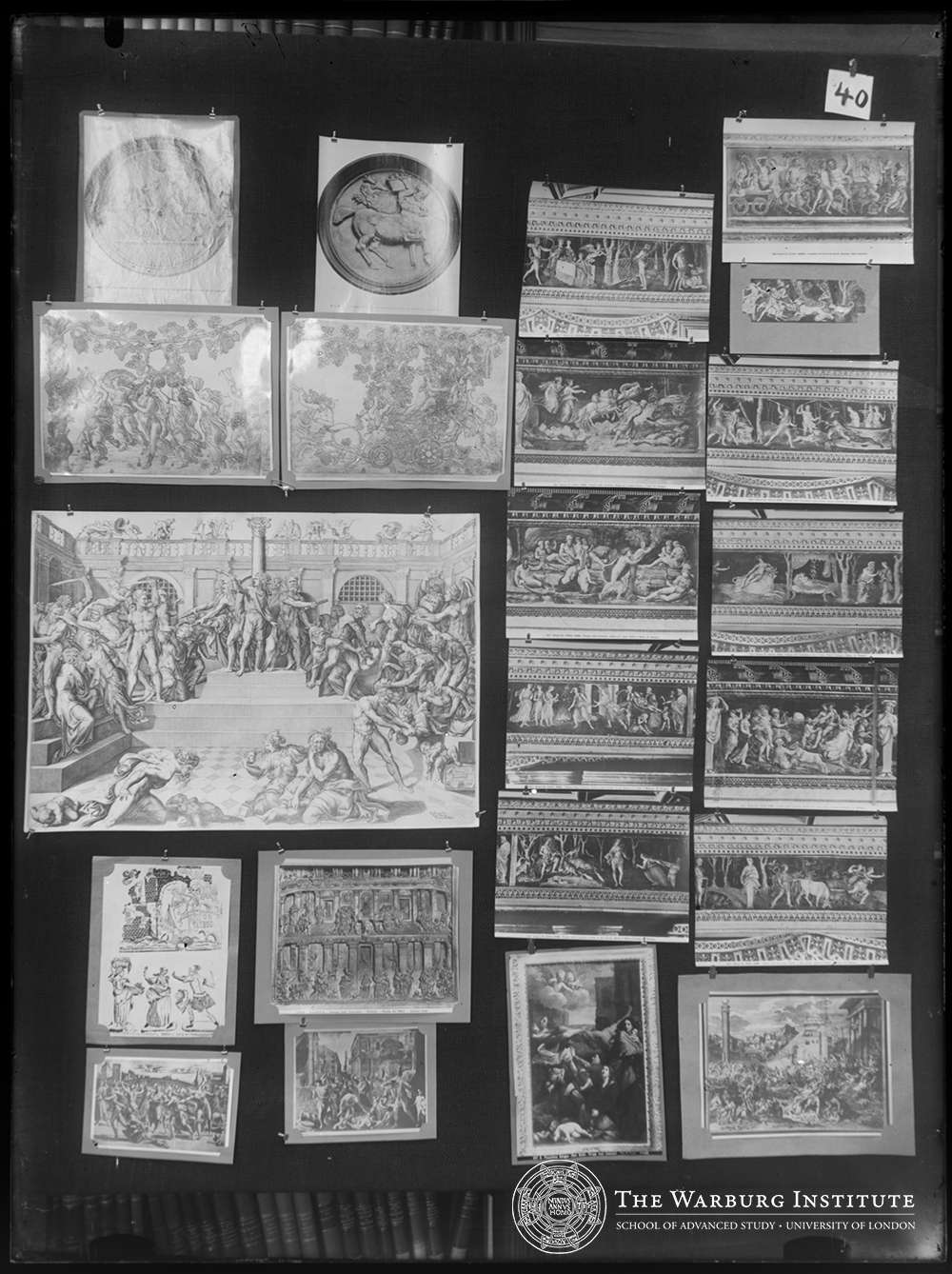
Appunti di Aby Warburg (1929)
Thiasos. Pathos
Tiaso, pathos.
Appunti di Aby Warburg e collaboratori (1929)
Durchbruch des antiken Temperaments. Kontinuierliche Darstellung (als Triumphzug antiker Gestalten? = Fries). Kindermord = rasende Mutter? Exzess der Pathosformel.
Irruzione del temperamento antico. Rappresentazione continuata (come corteo trionfale di figure antiche? = fregio). Infanticidio = madre furiosa? Eccesso della formula di pathos.
Appunti di Gertrud Bing (1940 ca)
Die rasende Bewegung, der Rausch, die Thyasotische Prozession, Herkunft aus dem Kreis des Bacchischen angedeutet durch Bacchus-Medaillons im Pal. Med. und Bacchus-stich. Die ausgelassene Heiterkeit. Ovid-Metamorphosen in der Villa Farnesina: Fries als vorbeiziehende Prozession. Der mythische Hintergrund der idyllischen Erzählung zeigt sich in der leidenschaftlichen Gebärdensprache. Umschwung ins Rasen und Ausbruch am Thema des Kindermordes: der Blutrausch der Soldaten, die Verzweiflung der Mütter. Dazu Geschichte: Plinius (?) bis Marino, Kind das mit der Milch zugleich das Blut der Mutter trinkt. Bildbeschreibung? Unter suchen ob die verschiedenen Beispiele der K.M. Darstellung verschiedenes bedeuten. Was z.B. das Terracotta-Relief? Der Marc Anton statuarisch und daher distanziert. Relief architektonisch oder bühnen mäßig? Ich kenne nicht: vorletste Darstells lurks unter und zweite rechts oben.
Il movimento frenetico, l’ebbrezza, la processione tiasotica, hanno origine dal circolo bacchico come si vede nei medaglioni con Bacco a Palazzo Medici e dall’incisione con Bacco. L’ebbrezza sfrenata. Le Metamorfosi di Ovidio a Villa Farnesina: fregi come una processione in corteo. Lo sfondo mitico del racconto idilliaco si rivela in un linguaggio gestuale carico di pathos. Una svolta è nella corsa e nella fuga: sul tema della Strage degli innocenti: la sete di sangue dei soldati, la disperazione delle madri. La Storia: Plinio (?) in Gianbattista Marino; bambino che succhia il sangue della madre insieme al latte. Descrizione dell’immagine? Cercare di capire se i diversi esempi di raffigurazione dell’infanticidio hanno significati diversi. Cosa significa, ad esempio, il rilievo in terracotta? Marcantonio Raimondi è statuario e di conseguenza distante. Rilievo architettonico o scenografia? Non conosco: la penultima figura in basso a sinistra e la seconda in alto a destra.
Notes by Aby Warburg (1929)
Thiasos. Pathos
Thiasus, pathos.
Notes by Aby Warburg and coll. (1929)
Durchbruch des antiken Temperaments. Kontinuierliche Darstellung (als Triumphzug antiker Gestalten? = Fries). Kindermord = rasende Mutter? Exzess der Pathosformel.
Breakthrough of the antique spirit. Continuous depictions (as a triumphal procession of antique figures? = frize). Infanticide = frenzied mother? Excessive application of the pathos formula.
Notes by Gertrud Bing (ca. 1940)
Die rasende Bewegung, der Rausch, die Thyasotische Prozession, Herkunft aus dem Kreis des Bacchischen angedeutet durch Bacchus-Medaillons im Pal. Med. und Bacchus-stich. Die ausgelassene Heiterkeit. Ovid-Metamorphosen in der Villa Farnesina: Fries als vorbeiziehende Prozession. Der mythische Hintergrund der idyllischen Erzählung zeigt sich in der leidenschaftlichen Gebärdensprache. Umschwung ins Rasen und Ausbruch am Thema des Kindermordes: der Blutrausch der Soldaten, die Verzweiflung der Mütter. Dazu Geschichte: Plinius (?) bis Marino, Kind das mit der Milch zugleich das Blut der Mutter trinkt. Bildbeschreibung? Unter suchen ob die verschiedenen Beispiele der K.M. Darstellung verschiedenes bedeuten. Was z.B. das Terracotta-Relief? Der Marc Anton statuarisch und daher distanziert. Relief architektonisch oder bühnen mäßig? Ich kenne nicht: vorletste Darstells lurks unter und zweite rechts oben.
The frenetic movement, the rapture, the thiasotic procession, originate from the Bacchic circle as seen in the medallions with Bacchus in the Medici Palace and the engraving with Bacchus. The exuberant rapture. Ovid’s Metamorphoses at the Villa Farnesina: friezes as a passing procession. The mythical background of the idyllic tale is revealed in a gestural language charged with pathos. A turning point is in the run and run on the theme of the Massacre of the Innocents: the bloodlust of the soldiers, the desperation of the mothers. The Story: Pliny (?) in Gianbattista Marino; child sucking his mother’s blood along with milk. Description of the image? See if the various examples of depiction of infanticide have different meanings. What, for example, does the terracotta relief mean? Marcantonio Raimondi is statuesque and therefore distant. Architectural relief or scenography? I don’t know: the penultimate figure on the bottom left and the second on the top right.
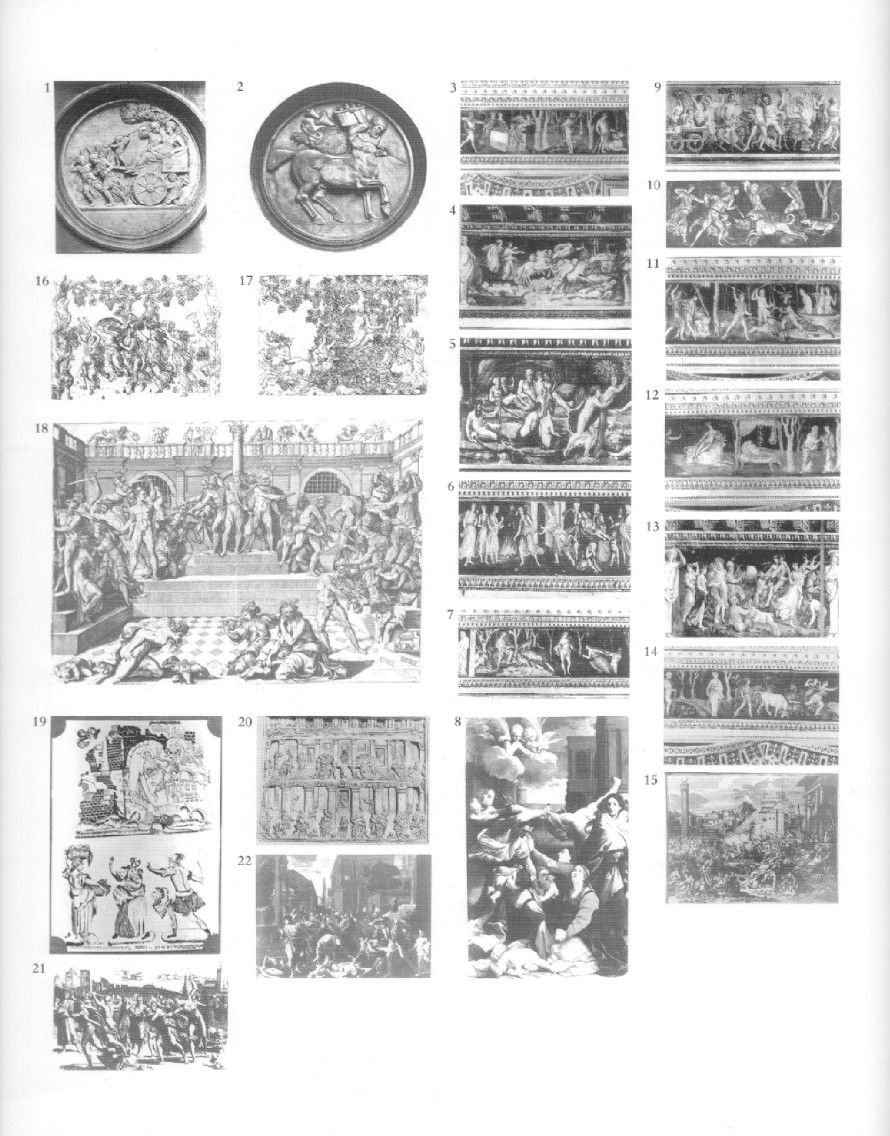
1. Maso di Bartolomeo, Trionfo d'Amore, tondo in marmo (da una gemma antica), 1452, Firenze, cortile del Palazzo Medici-Riccardi
2. Maso di Bartolomeo, Centauro, tondo in marmo da una gemma antica, 1452, Firenze, cortile del Palazzo Medici-Riccardi
3. Baldassarre Peruzzi, Scene mitologiche (dalle Metamorfosi di Ovidio): Le fatiche di Ercole, affresco, 1510-1518, Roma, Villa Farnesina, Sala del Fregio
4. Baldassarre Peruzzi, Scene mitologiche (dalle Metamorfosi di Ovidio): Aurora e Cefalo, affresco, 1510-1518, Roma, Villa Farnesina, Sala del Fregio
5. Baldassarre Peruzzi, Scene mitologiche (dalle Metamorfosi di Ovidio): Apollo e Dafne, affresco, 1510-1518, Roma, Villa Farnesina, Sala del Fregio
6. Baldassarre Peruzzi, Scene mitologiche (dalle Metamorfosi di Ovidio): Morte di Meleagro, affresco, 1510-1518, Roma, Villa Farnesina, Sala del Fregio
7. Baldassarre Peruzzi, Scene mitologiche (dalle Metamorfosi di Ovidio): Orfeo ed Euridice, affresco, 1510-1518, Roma, Villa Farnesina, Sala del Fregio
8. Guido Reni, La strage degli innocenti, 1611, dipinto su tela, Bologna, Pinacoteca Nazionale
9. Matteo Balducci, Trionfo di Bacco e Arianna, cassone, prima metà del sec. XVI, Gubbio, Pinacoteca del Palazzo dei Consoli
10. Baldassarre Peruzzi, Scene mitologiche (dalle Metamorfosi di Ovidio): La caccia al cinghiale di Meleagro, affresco, 1510-1518, Roma, Villa Farnesina, Sala del Fregio
11. Baldassarre Peruzzi, Scene mitologiche (dalle Metamorfosi di Ovidio): Diana, morte di Atteone, affresco, 1510-1518, Roma, Villa Farnesina, Sala del Fregio
12. Baldassarre Peruzzi, Scene mitologiche (dalle Metamorfosi di Ovidio): Ratto di Europa, Danae, Giove e Semele, affresco, 1510-1518, Roma, Villa Farnesina, Sala del Fregio
13. Baldassarre Peruzzi, Scene mitologiche (dalle Metamorfosi di Ovidio): Bacco e Arianna, affresco, 1510-1518, Roma, Villa Farnesina, Sala del Fregio
14. Baldassarre Peruzzi, Scene mitologiche (dalle Metamorfosi di Ovidio): Ercole e Mercurio, Mercurio con il gregge di Apollo, Ratto di Europa, affresco, 1510-1518, Roma, Villa Farnesina, Sala del Fregio
15. Bernart Picart, La strage degli innocenti, incisione da Barhold Heinrich Brockes, Verteutschter Bethlemitischer Kindermord des Ritter Marino, Tübingen 1739
16. Trionfo di Bacco, Trionfo di Arianna, acquaforte su rame da Botticelli, 1480-1490, London, The British Museum
17. Trionfo di Bacco, Trionfo di Arianna, acquaforte su rame da Botticelli, 1480-1490, London, The British Museum
18. Marcantonio Raimondi o Marco Dente (da Baccio Bandinelli), La strage degli innocenti, acquaforte su rame, 1520 ca.
19. Fuga in Egitto e strage degli innocenti, xilografia dalle illustrazione di un testo, Brescia 1921
20. Bartolomeo Bellano, Giudizio di Salomone, bassorilievo in bronzo, 1484-1488, Padova, Basilica di Sant'Antonio
21. Marcantonio Raimondi (da Raffaello), Strage degli innocenti, acquaforte su rame, sec. XVI, Roma, Palazzo Barberini, Galleria Nazionale d'Arte Antica
22. Nicolas Poussin, La peste ad Ashdod, olio su tela, 1630, Paris, Musée du Louvre
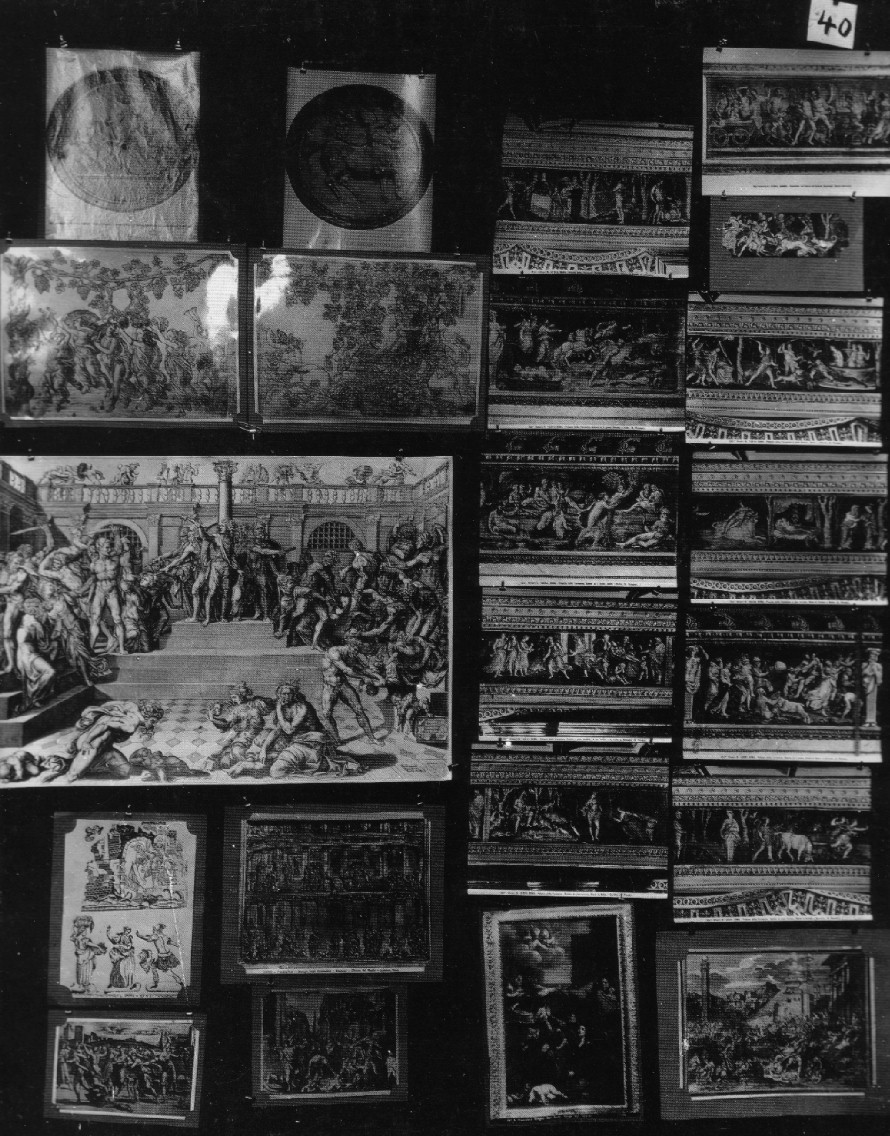
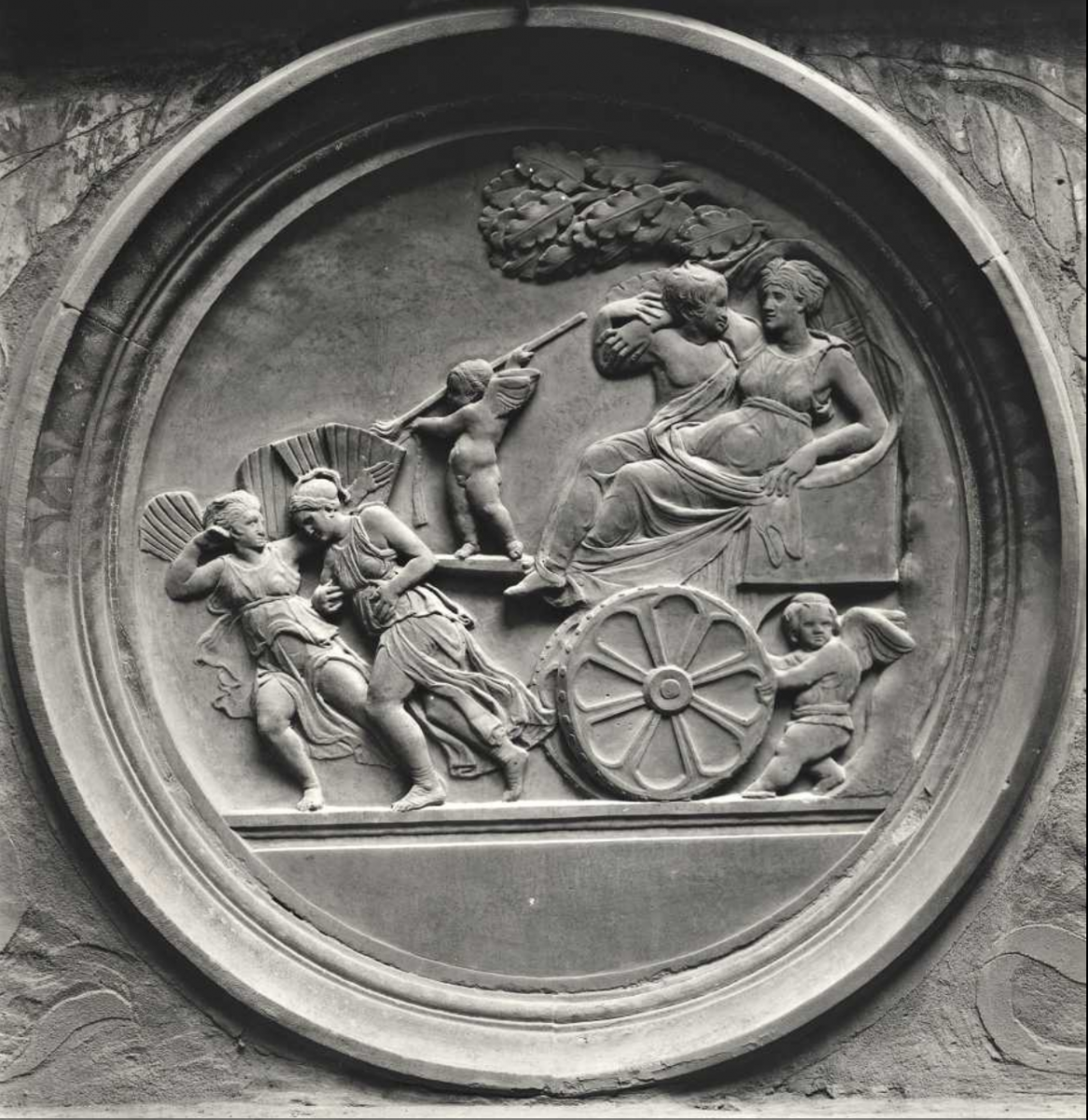
40.1. Bertoldo di Giovanni (attribuito), Trionfo di Bacco e Arianna, tondo in marmo (da una gemma antica), 1452. Firenze, cortile del Palazzo Medici-Riccardi.
40.1 Bertoldo di Giovanni (attributed), The triumph of Bacchus and Ariadne, marble tondo (from an ancient gem), 1452. Firenze, courtyard of the Medici-Riccardi Palace.
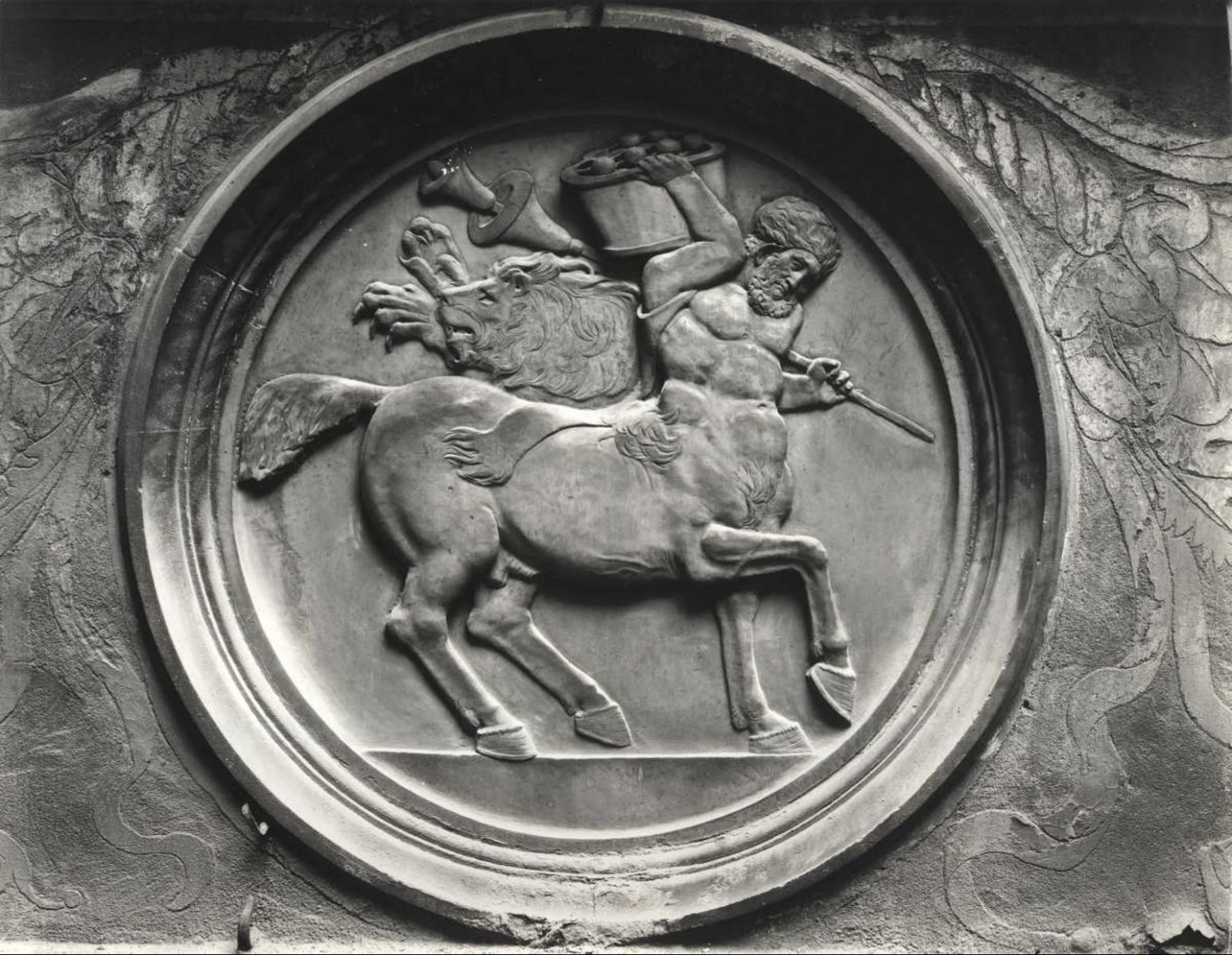
40.2. Bertoldo di Giovanni (attribuito), Centauro, tondo in marmo (da una gemma antica), 1452. Firenze, cortile del Palazzo Medici-Riccardi.
40.2. Bertoldo di Giovanni (attributed), Centaur, marble tondo (from an ancient gem), 1452. Firenze, courtyard of the Medici-Riccardi Palace.

40.3 Baldassarre Peruzzi, Le fatiche di Ercole (particolare del fregio con scene dalle Metamorfosi di Ovidio), affresco, 1510-1518, Roma, Villa Farnesina, Sala del Fregio, parete nord.
40.3 Baldassarre Peruzzi, The Labors of Hercules (detail of the frieze with scenes from Ovid's Metamorphoses), fresco, 1510-1518, Roma, Villa Farnesina, Hall of the frieze, north wall.

40.4 Baldassarre Peruzzi, Aurora e Cefalo (particolare del fregio con scene dalle Metamorfosi di Ovidio), affresco, 1510-1518, Roma, Villa Farnesina, Sala delle prospettive, parete nord.
40.4 Baldassarre Peruzzi, Aurora and Cephalus (detail of the frieze with scenes from Ovid's Metamorphoses), fresco, 1510-1518, Roma, Villa Farnesina, Hall of the perspectives, north wall.
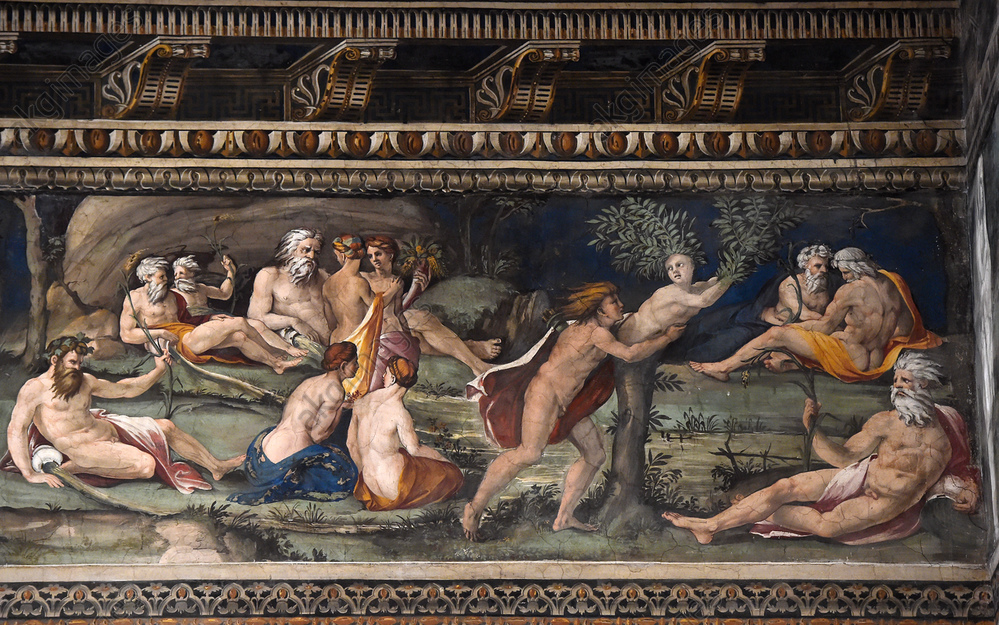
40.5. Baldassarre Peruzzi, Apollo e Dafne (particolare del fregio con scene dalle Metamorfosi di Ovidio), affresco, 1510-1518, Roma, Villa Farnesina, Sala delle prospettive, parete ovest.
40.5 Baldassarre Peruzzi, Apollo and Daphne (detail of the frieze with scenes from Ovid's Metamorphoses), fresco, 1510-1518, Roma, Villa Farnesina, Hall of the perspectives, west wall.
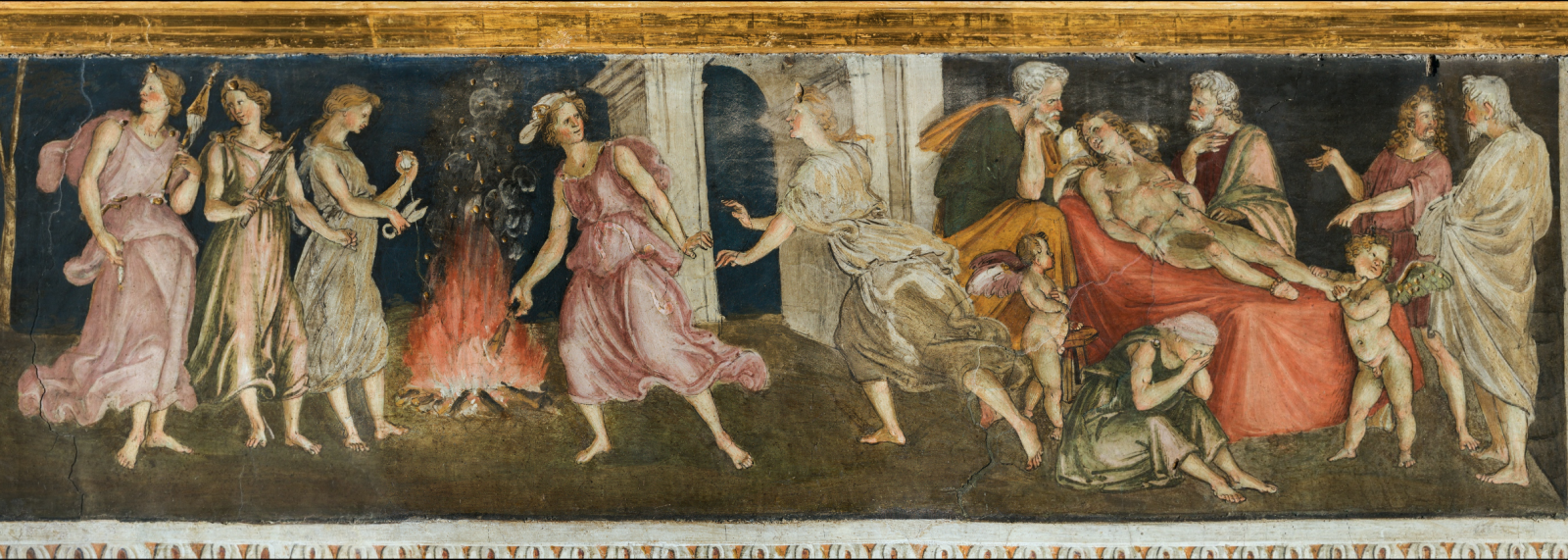
40.6. Baldassarre Peruzzi, Morte di Meleagro (particolare del fregio con scene dalle Metamorfosi di Ovidio), affresco, 1510-1518, Roma, Villa Farnesina, Sala del Fregio, parete ovest.
40.6. Baldassarre Peruzzi, Death of Meleager (detail of the frieze with scenes from Ovid's Metamorphoses), fresco, 1510-1518, Roma, Villa Farnesina, Hall of the frieze, west wall.
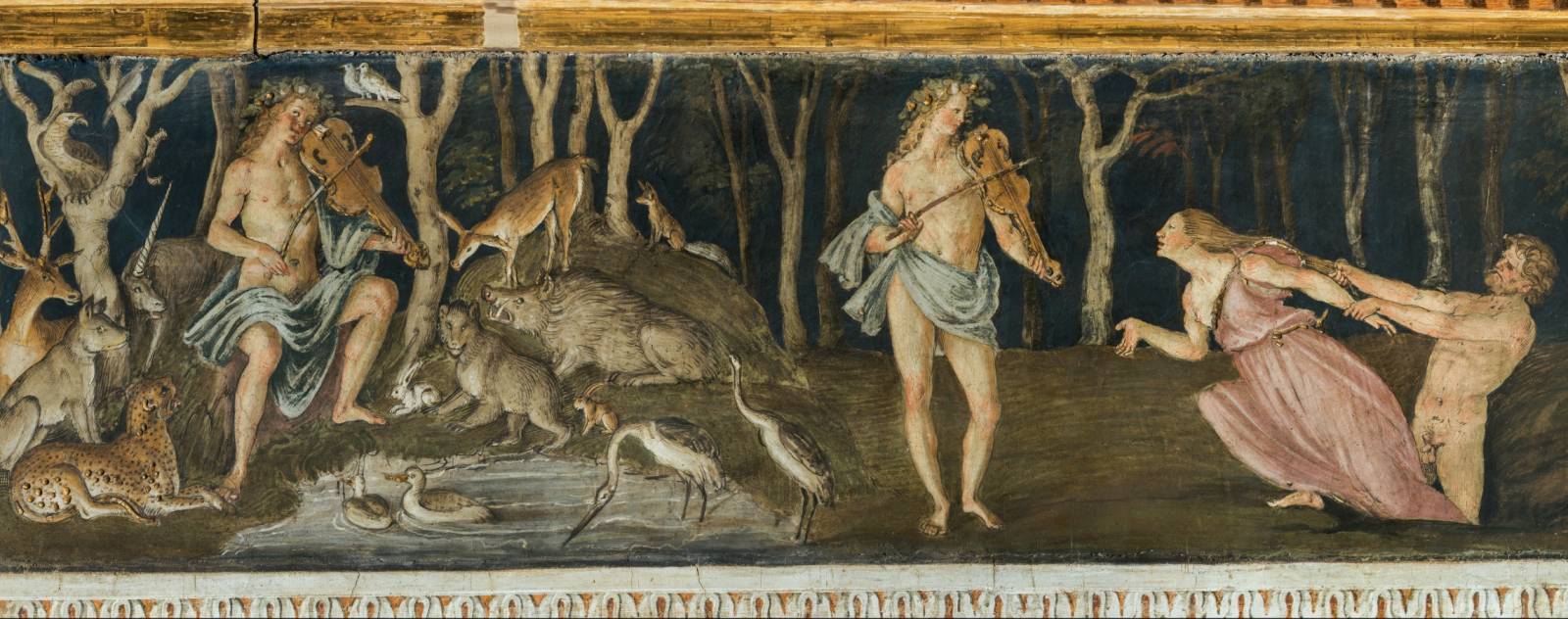
40.7. Baldassarre Peruzzi, Orfeo ed Euridice (particolare del fregio con scene dalle Metamorfosi di Ovidio), affresco, 1510-1518, Roma, Villa Farnesina, Sala del Fregio, parete ovest.
40.7. Baldassarre Peruzzi, Orpheus and Eurydice (detail of the frieze with scenes from Ovid's Metamorphoses), fresco, 1510-1518, Roma, Villa Farnesina, Hall of the frieze, west wall.
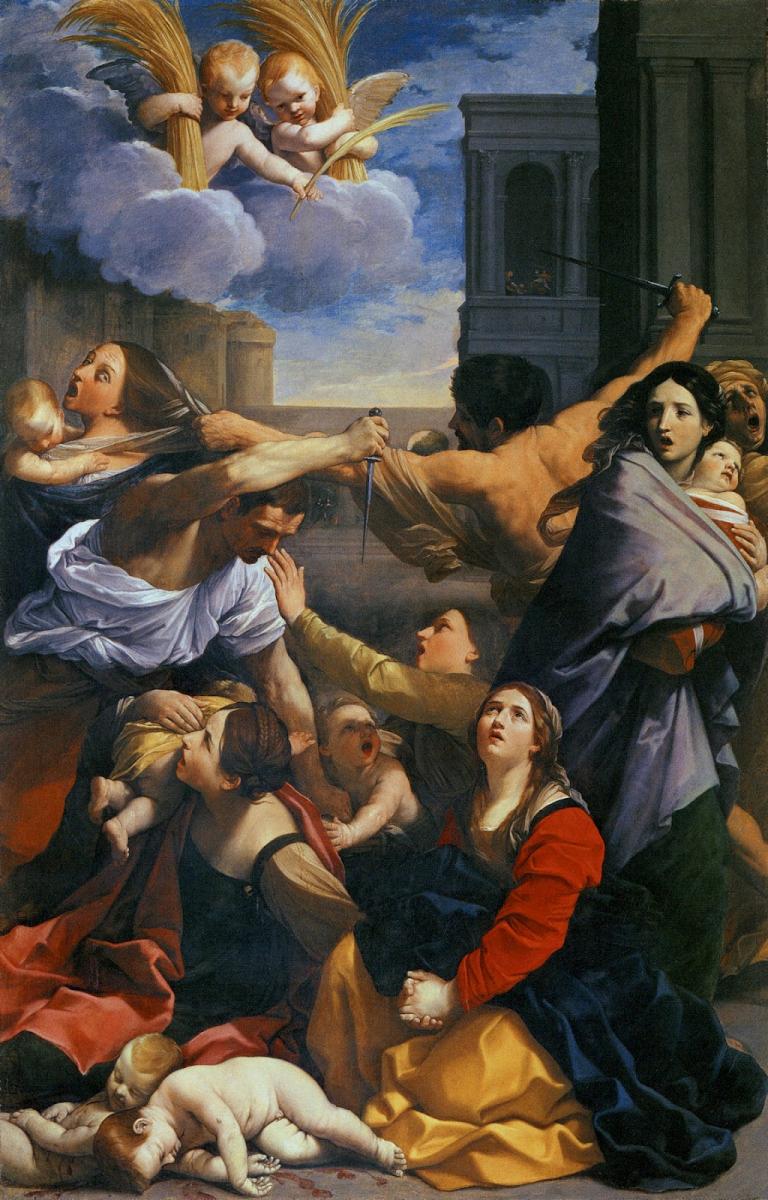
40.8. Guido Reni, La strage degli innocenti, olio su tela (268 × 170 cm), 1611. Bologna, Pinacoteca Nazionale.
40.8. Guido Reni, Massacre of the Innocents, oil on canvas (268 × 170 cm), 1611. Bologna, Pinacoteca Nazionale.
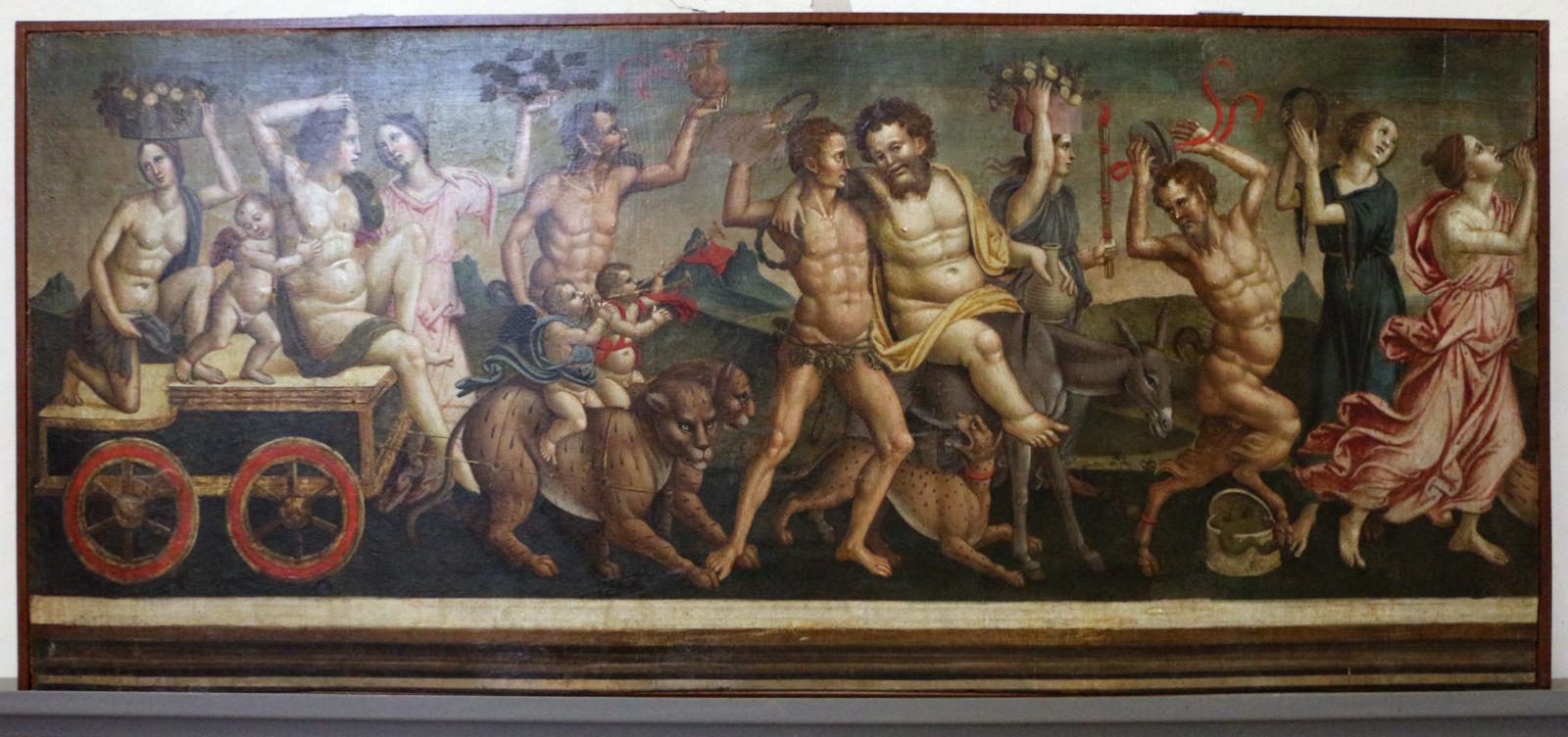
40.9. Matteo Balducci (o Amico Aspertini), Trionfo di Bacco e Arianna, cassone nuziale, 1490-1552. Gubbio, Pinacoteca del Palazzo dei Consoli.
40.9. Matteo Balducci (o Amico Aspertini), Triumph of Bacchus and Ariadne, wedding chest, 1490-1552. Gubbio, Pinacoteca del Palazzo dei Consoli.

40.10. Baldassarre Peruzzi, La caccia al cinghiale di Meleagro (particolare del fregio con scene dalle Metamorfosi di Ovidio), affresco, 1510-1518, Roma, Villa Farnesina, Sala del Fregio, parete ovest.
40.10. Baldassarre Peruzzi, Calydonian boar hunt (detail of the frieze with scenes from Ovid's Metamorphoses), fresco, 1510-1518, Roma, Villa Farnesina, Hall of the frieze, west wall.
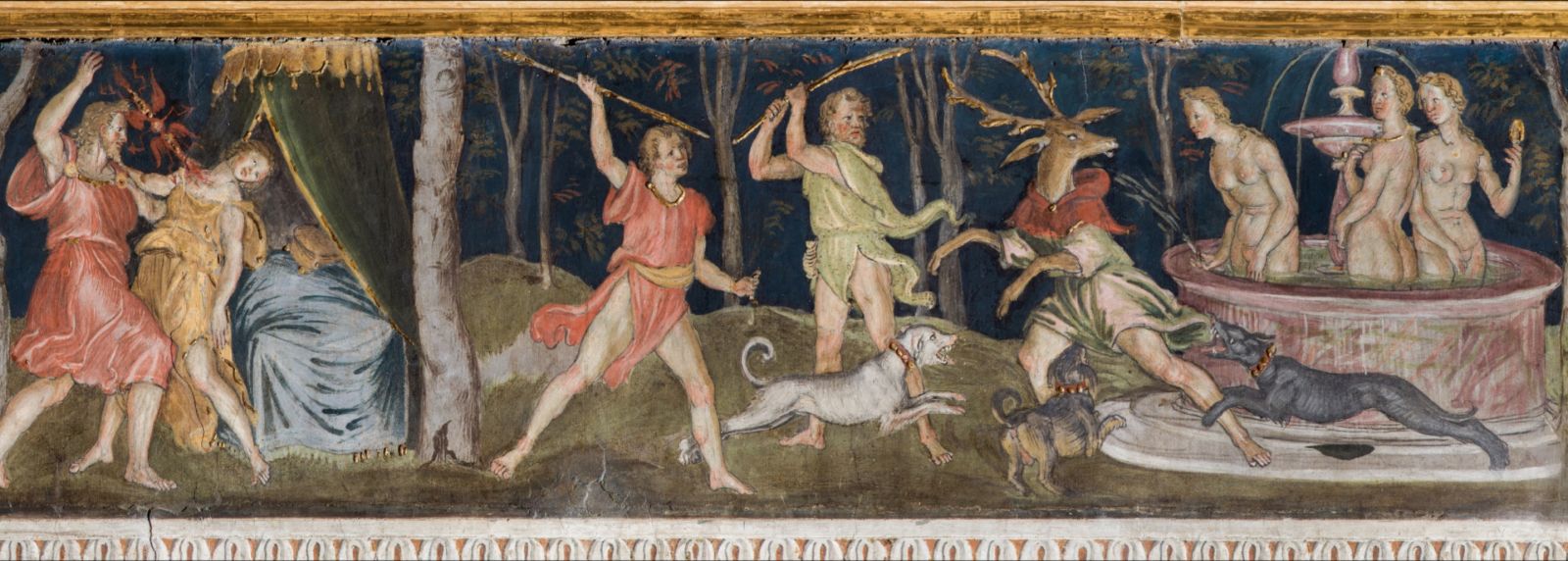
40.11. Baldassarre Peruzzi, Giove e Semele, morte di Atteone (particolare del fregio con scene dalle Metamorfosi di Ovidio), affresco, 1510-1518, Roma, Villa Farnesina, Sala del Fregio, parete est.
40.11. Baldassarre Peruzzi, Jupiter and Semele, death of Atteone (detail of the frieze with scenes from Ovid's Metamorphoses), fresco, 1510-1518, Roma, Villa Farnesina, Hall of the frieze, est wall.
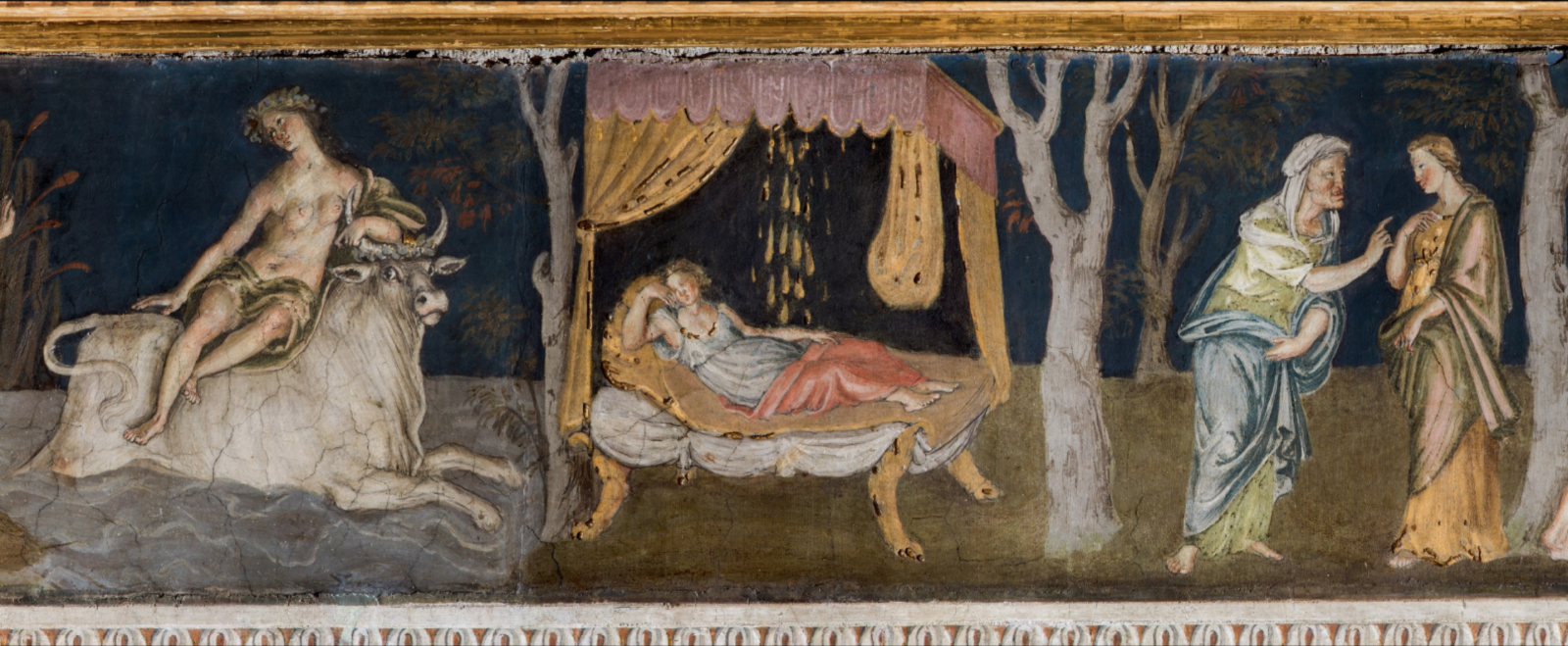
40.12. Baldassarre Peruzzi, Ratto di Europa, Danae, Giove e Semele (particolare del fregio con scene dalle Metamorfosi di Ovidio), affresco, 1510-1518, Roma, Villa Farnesina, Sala del Fregio, parete est.
40.12. Baldassarre Peruzzi, The Rape of Europa, Danaë and Jupiter and Semele (detail of the frieze with scenes from Ovid's Metamorphoses), fresco, 1510-1518, Roma, Villa Farnesina, Hall of the frieze, est wall.
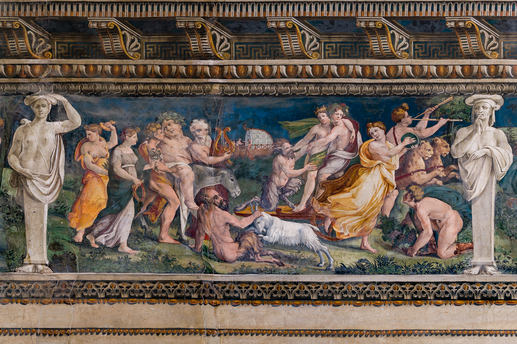
40.13. Baldassarre Peruzzi, Bacco e Arianna (particolare del fregio con scene dalle Metamorfosi di Ovidio), affresco, 1510-1518, Roma, Villa Farnesina, Sala delle prospettive, parete nord.
40.13. Baldassarre Peruzzi, Bacchus and Ariadne (detail of the frieze with scenes from Ovid's Metamorphoses), fresco, 1510-1518, Roma, Villa Farnesina, Hall of the perspectives, north wall.
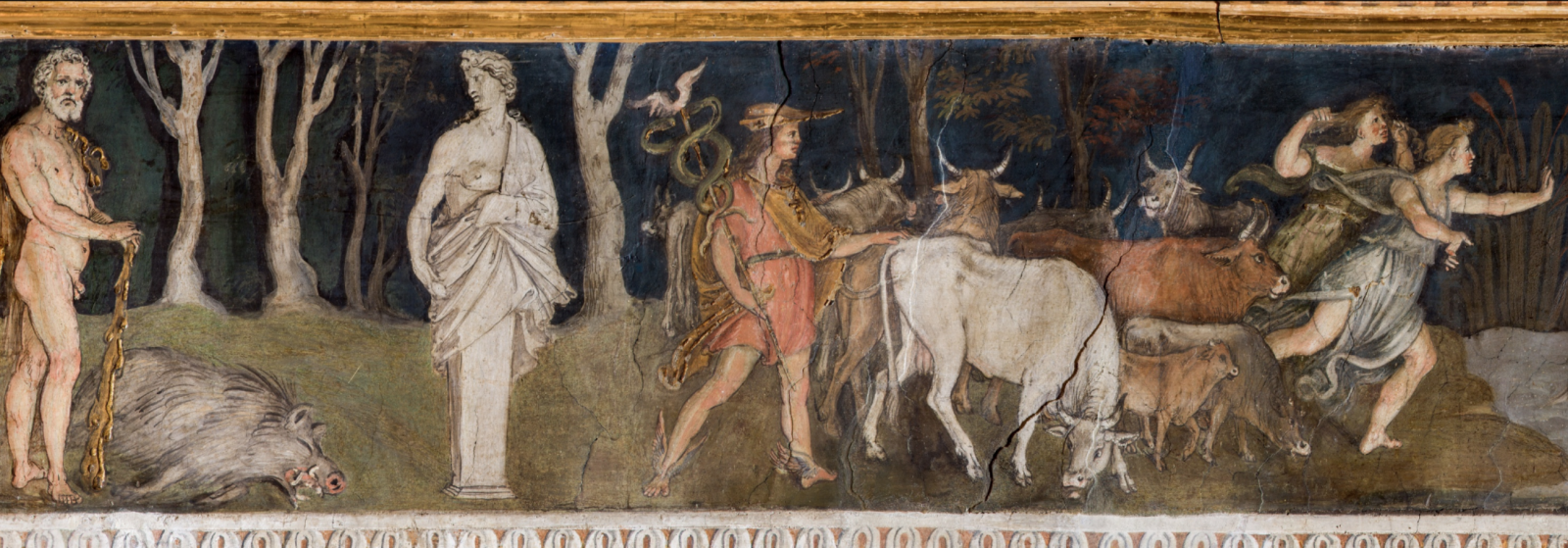
40.14. Baldassarre Peruzzi, Mercurio ruba le vacche sacre di Apollo, Ratto di Europa (particolare del fregio con scene dalle Metamorfosi di Ovidio), affresco, 1510-1518, Roma, Villa Farnesina, Sala del Fregio, parete est.
40.14. Baldassarre Peruzzi, The theft of Apollo’s cattle, The Rape of Europa (detail of the frieze with scenes from Ovid's Metamorphoses), fresco, 1510-1518, Roma, Villa Farnesina, Hall of the frieze, est wall.
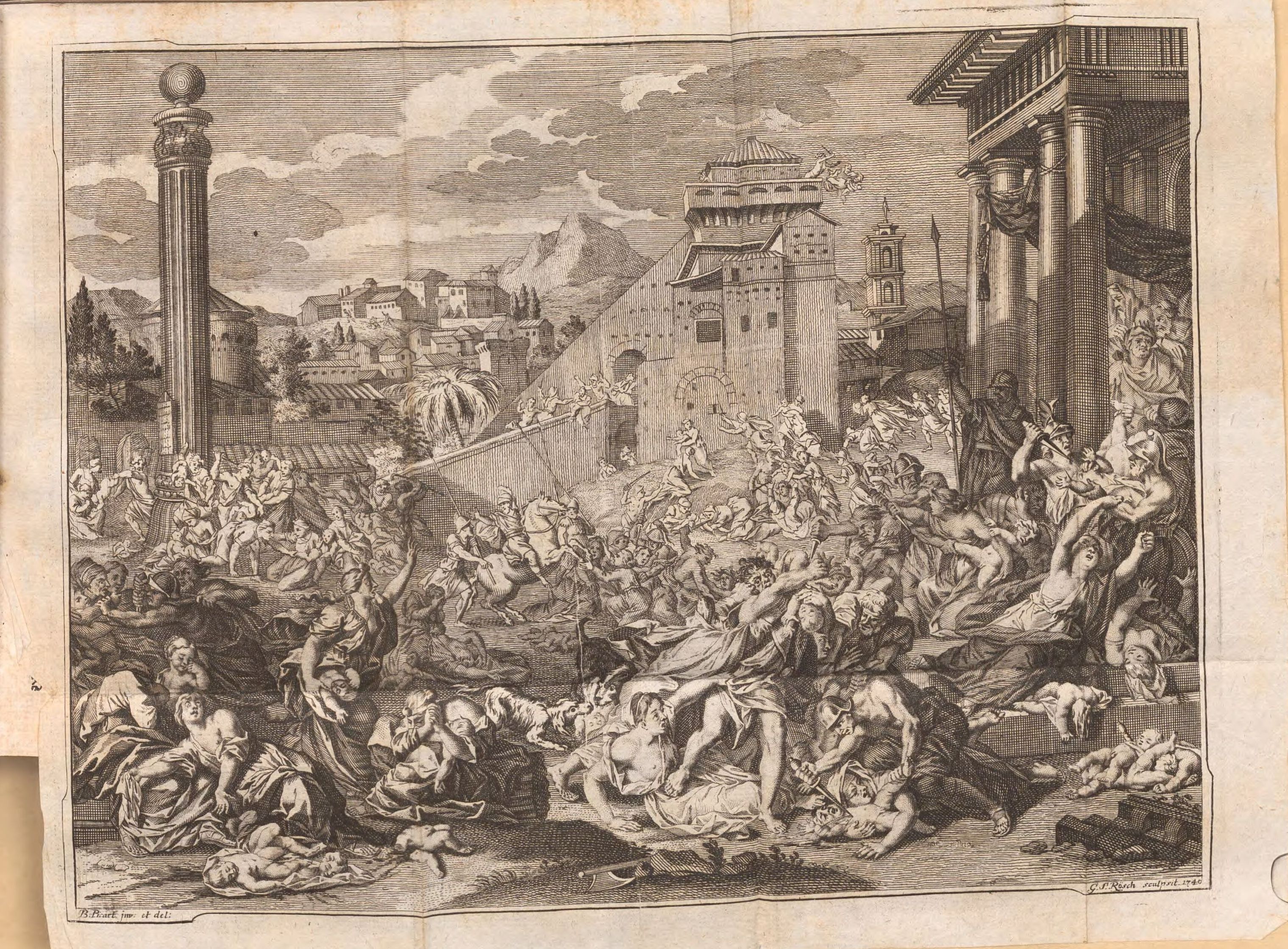
40.15. Bernart Picart, La strage degli innocenti, incisione.
40.15. Bernart Picart, Massacre of the Innocents, engraving.
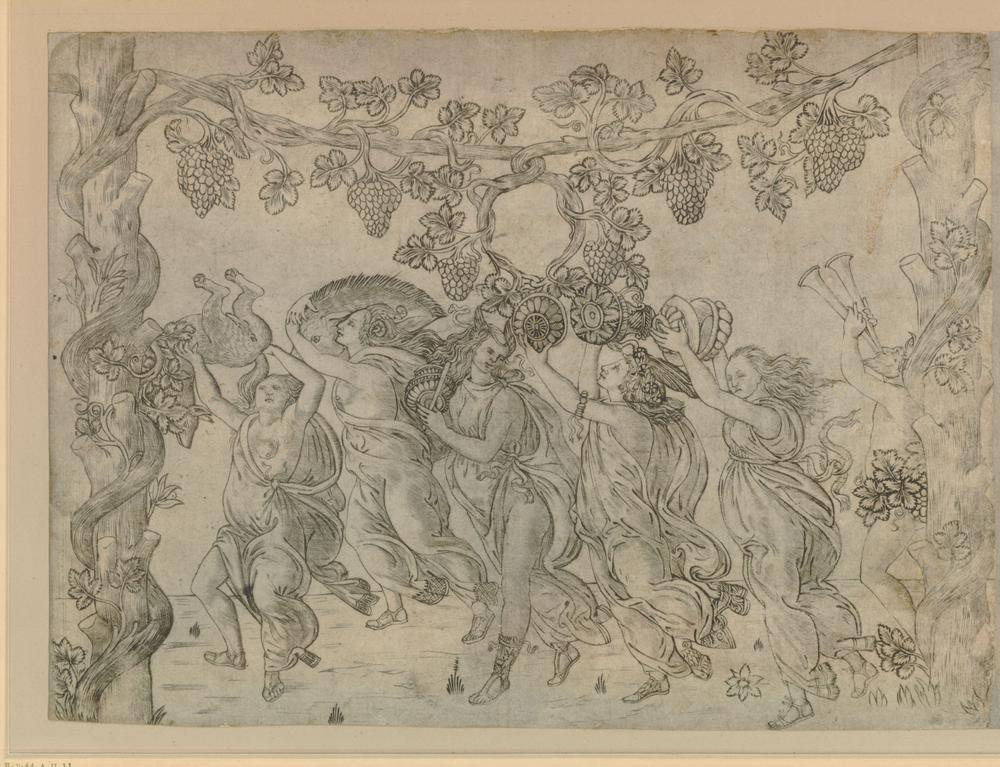
40.16. Anonimo fiorentino, Trionfo di Arianna, acquaforte su rame, 1480-1490. Londra, The British Museum.
40.16. Anonymouse, The triumph of Bacchus and Ariadne, engraving, 1480-1490. London, The British Museum.
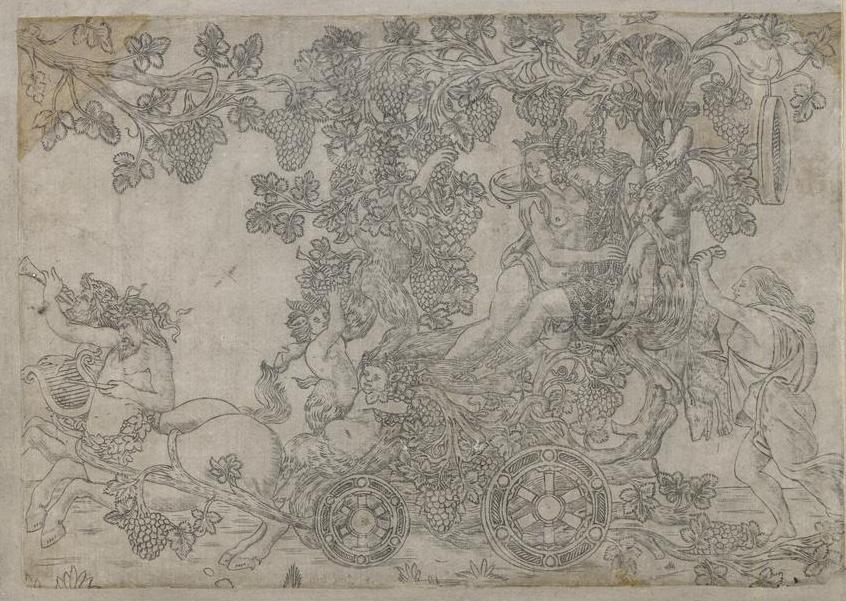
40.17. Anonimo fiorentino, Trionfo di Arianna, acquaforte su rame, 1480-1490. Londra, The British Museum.
40.17. Anonymous, The triumph of Bacchus and Ariadne, engraving, 1480-1490. London, The British Museum.
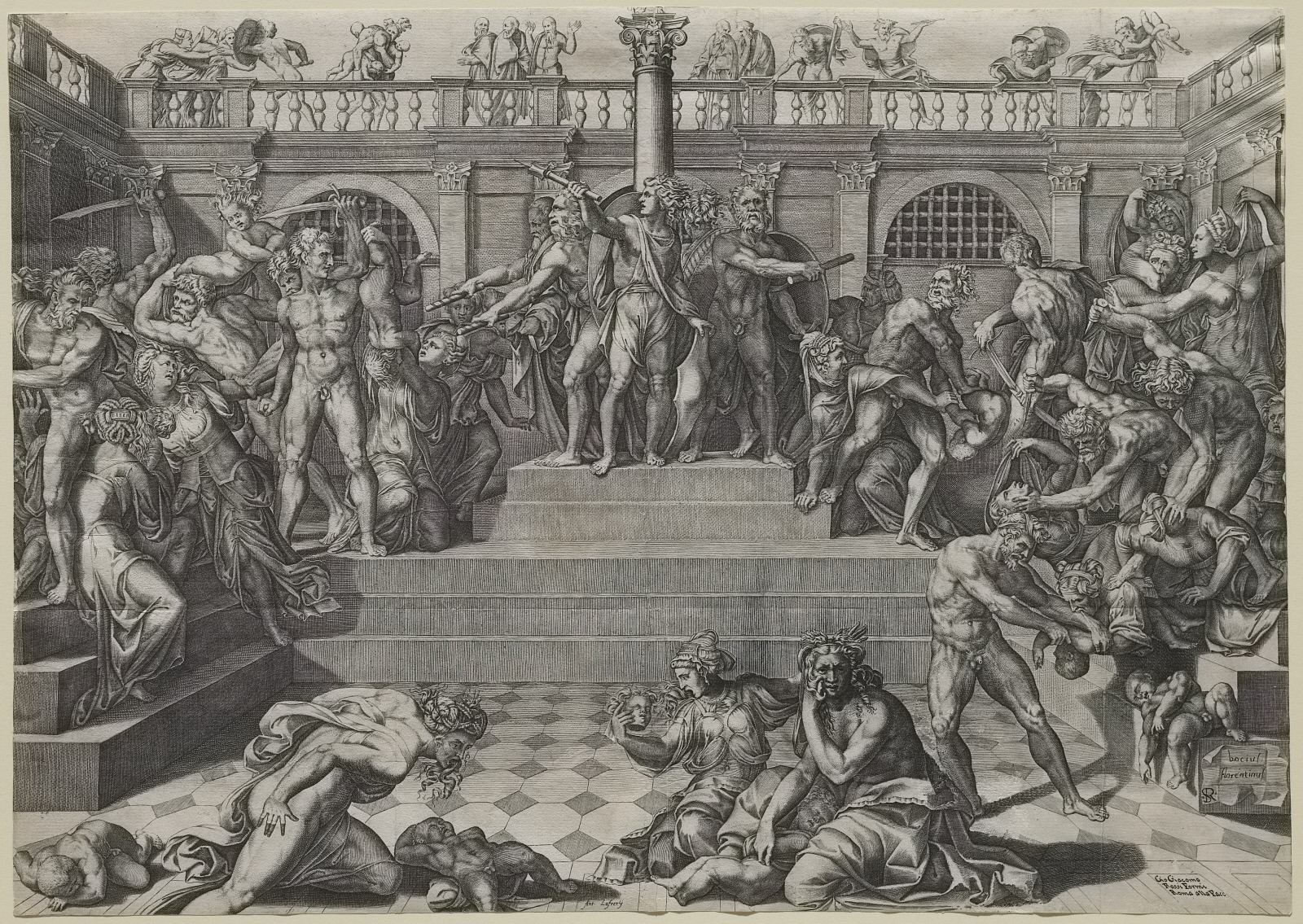
40.18. Marco Dente (da Baccio Bandinelli), La strage degli innocenti, acquaforte su rame, 1520 ca.
40.18. Marco Dente (from Baccio Bandinelli), The massacre of the innocents, etching on copper, 1520 ca.
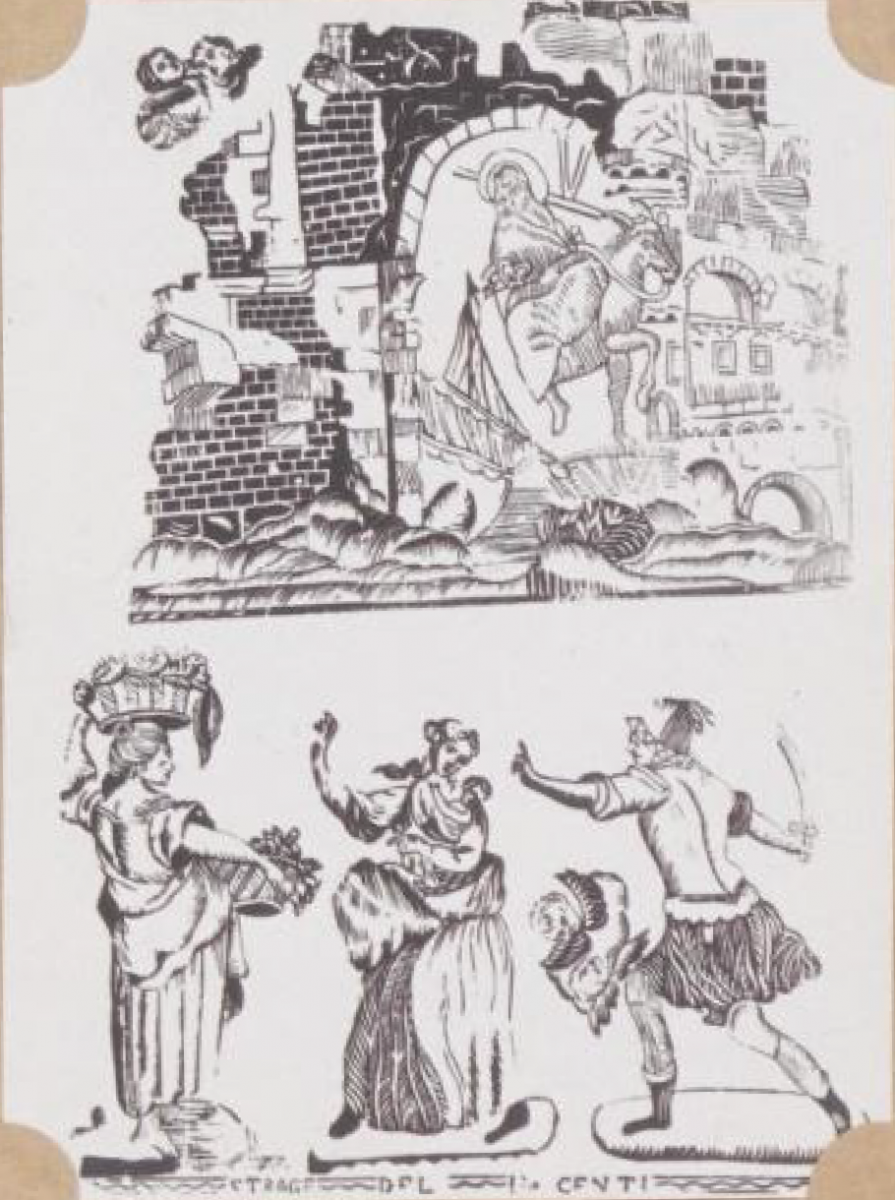
40.19. Fuga in Egitto e strage degli innocenti, xilografia dalle illustrazione di un testo, Brescia 1921.
40.19. Flight into Egypt and massacre of the innocents, woodcut from a text illustration, Brescia 1921.
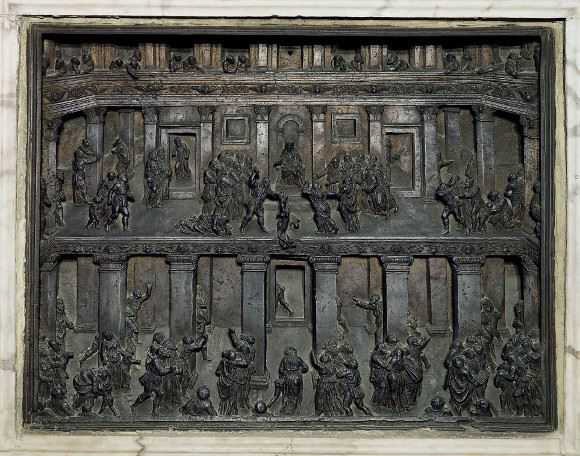
40.20. Bartolomeo Bellano, Giudizio di Salomone, bassorilievo in bronzo, 1484-1488. Padova, Basilica di Sant’Antonio.
40.20. Bartolomeo Bellano, Judgment of Solomon, bronze bas-relief, 1484-1488. Padova, Basilica of Sant’Antonio.
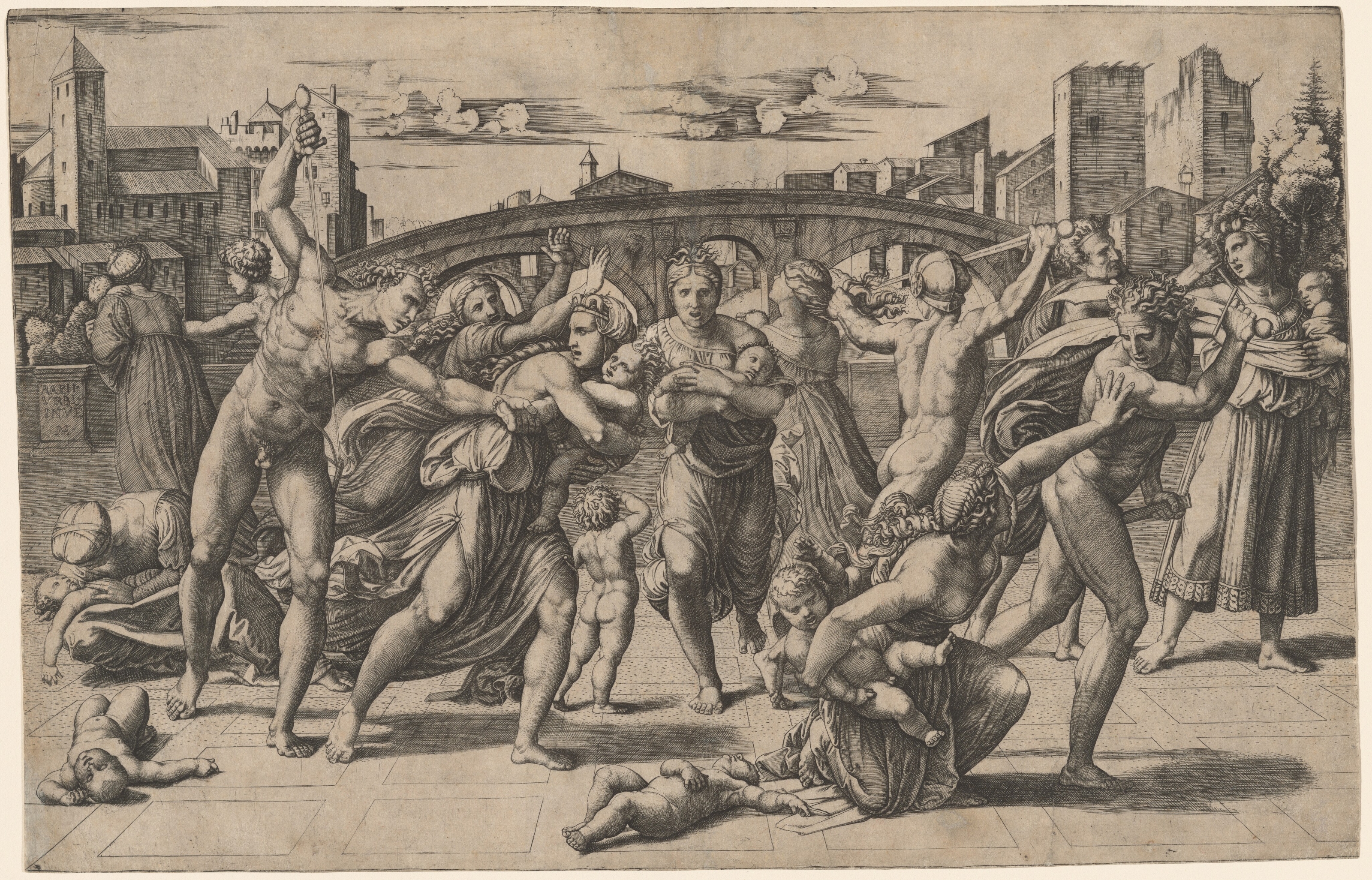
40.21. Marcantonio Raimondi (da Raffaello), Strage degli innocenti, acquaforte su rame, sec. XVI. Roma, Palazzo Barberini, Galleria Nazionale d’Arte Antica.
40.21. Marcantonio Raimondi (from Raphael), Massacre of the Innocents, etching on copper, 16th cent. XVI, Roma, Palazzo Barberini, Galleria Nazionale d’Arte Antica.
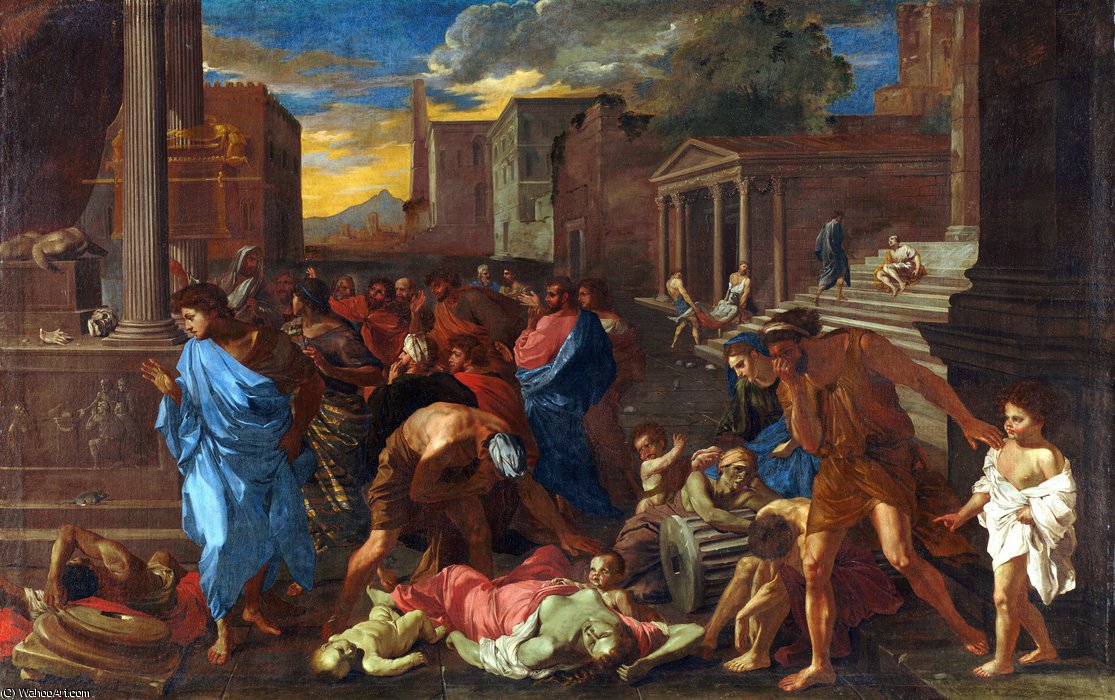
40.22. Nicolas Poussin, La peste ad Ashdod, olio su tela, 1630, Parigi, Museo del Louvre.
40.22. Nicolas Poussin, The Plague in Ashdod, oil on canvas, 1630, Paris, Musée du Louvre.
